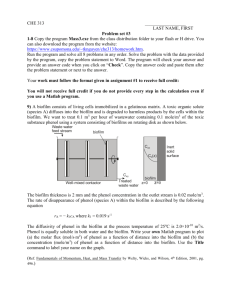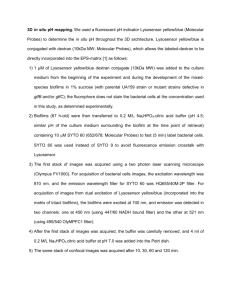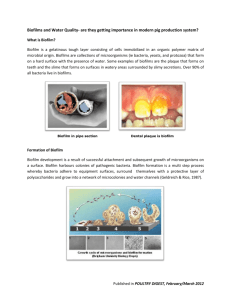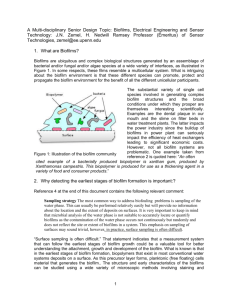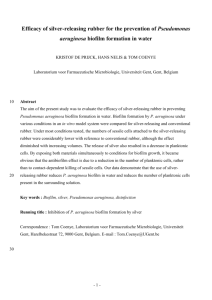Supplementary Information
advertisement
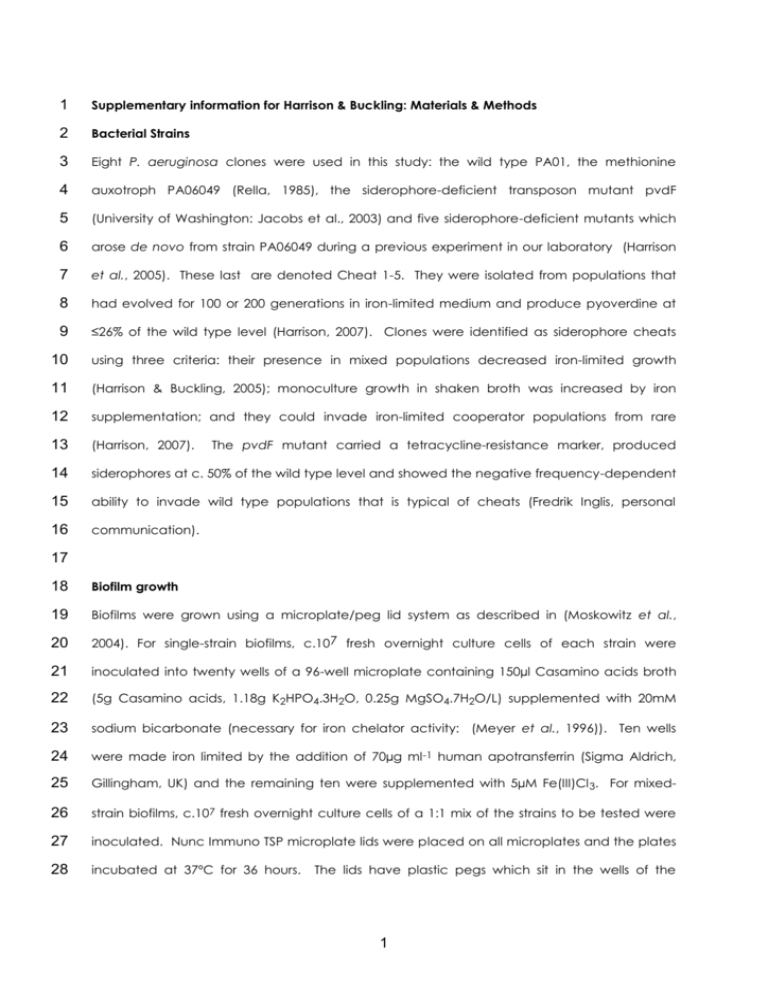
1 Supplementary information for Harrison & Buckling: Materials & Methods 2 Bacterial Strains 3 Eight P. aeruginosa clones were used in this study: the wild type PA01, the methionine 4 auxotroph PA06049 (Rella, 1985), the siderophore-deficient transposon mutant pvdF 5 (University of Washington: Jacobs et al., 2003) and five siderophore-deficient mutants which 6 arose de novo from strain PA06049 during a previous experiment in our laboratory (Harrison 7 et al., 2005). These last are denoted Cheat 1-5. They were isolated from populations that 8 had evolved for 100 or 200 generations in iron-limited medium and produce pyoverdine at 9 ≤26% of the wild type level (Harrison, 2007). Clones were identified as siderophore cheats 10 using three criteria: their presence in mixed populations decreased iron-limited growth 11 (Harrison & Buckling, 2005); monoculture growth in shaken broth was increased by iron 12 supplementation; and they could invade iron-limited cooperator populations from rare 13 (Harrison, 2007). 14 siderophores at c. 50% of the wild type level and showed the negative frequency-dependent 15 ability to invade wild type populations that is typical of cheats (Fredrik Inglis, personal 16 communication). The pvdF mutant carried a tetracycline-resistance marker, produced 17 18 Biofilm growth 19 Biofilms were grown using a microplate/peg lid system as described in (Moskowitz et al., 20 2004). For single-strain biofilms, c.107 fresh overnight culture cells of each strain were 21 inoculated into twenty wells of a 96-well microplate containing 150µl Casamino acids broth 22 (5g Casamino acids, 1.18g K2HPO4.3H2O, 0.25g MgSO4.7H2O/L) supplemented with 20mM 23 sodium bicarbonate (necessary for iron chelator activity: (Meyer et al., 1996)). Ten wells 24 were made iron limited by the addition of 70µg ml -1 human apotransferrin (Sigma Aldrich, 25 Gillingham, UK) and the remaining ten were supplemented with 5µM Fe(III)Cl 3. For mixed- 26 strain biofilms, c.107 fresh overnight culture cells of a 1:1 mix of the strains to be tested were 27 inoculated. Nunc Immuno TSP microplate lids were placed on all microplates and the plates 28 incubated at 37ºC for 36 hours. The lids have plastic pegs which sit in the wells of the 1 29 microplate and on which biofilms form. This system allows large numbers of biofilms to be 30 grown and assayed simply and rapidly. 31 32 6.4.3 Assessment of biofilm growth 33 Peg lids were washed with M9 minimal salts, transferred to a microplate containing 150µl 34 crystal violet solution (Pro-Lab Diagnostics, Neston, UK) per well, incubated for 15 minutes at 35 room temperature, rinsed twice with ddH2O and dried in a laminar flow hood for 30 minutes. 36 The crystal violet was then solubilised by placing peg lids in a microplate containing 150µl 95% 37 ethanol per well and incubating for 15 minutes at room temperature. The absorbance at 38 590nm of each well was measured and this value was taken as a measure of absolute biofilm 39 density. 40 For single-strain populations, the cell density of the planktonic subpopulation was 41 assayed by reading the absorbance at 650nm of each broth culture and comparing the 42 value obtained with a strain-specific calibration curve. A measure of the relative allocation 43 of cells to the biofilm in each well was calculated by dividing the A 590 of each crystal violet- 44 treated peg by the number of colony-forming units present in the corresponding well. 45 The single-species biofilm data revealed a positive correlation between biofilm mass 46 (crystal violet stain) and relative biofilm allocation (ANOVA: mass = clone + biofilm allocation 47 + clone*biofilm allocation; iron-limited F1,48=161.91, p<0.001; iron-supplemented F1,48=3.91, 48 p<0.001). Therefore, we analysed only total biofilm mass. 49 50 6.4.3 Morphological study 51 Seven populations of PA01 and ten populations of each of the mixes were grown as above. 52 Aliquots of diluted planktonic and biofilm subpopulations were plated on casamino acids 53 agar plates. The primary siderophore of Pseudomonas spp., pyoverdine, fluoresces yellow- 54 green under visible light and so allows easy visual scoring of pyoverdine-producing and 55 pyoverdine-negative colonies after overnight growth at 37ºC. Because the pvdF insertion 56 mutant produced siderophores at c. 50% of the wild-type level, visual scoring was not feasible 2 57 for PA01+pvdF biofilms; instead, aliquots of planktonic and biofilm subpopulations were 58 replica plated on casamino acids agar plates with and without 60µg ml -1 tetracycline. 59 60 6.4.4 Statistical analyses 61 Data were analysed using Minitab 14. Data for planktonic CFU under both iron regimes were 62 arcsine square root transformed. Data for biofilm mass and iron-limited/iron-supplemented 63 ratios were transformed using the natural logarithm. These transformations provided the best 64 fit to the assumptions of parametric statistical tests in each case. Cheat frequency data 65 were not transformed and were analysed non-parametrically. 66 under iron limitation, the expected biofilm mass for each population was calculated as 67 p(x mutan t ) (1 p)(x PA01) , where p =proportion of cheats in the biofilm, x mutan t =mean biofilm 68 69 mass obtained in pure cultures of that mutant clone and mass. For mixed biofilms grown x PA01 =mean PA01 pure biofilm 70 Where multiple T-tests were performed to compare the evolved clones with PA06049, 71 the value of alpha was adjusted using the false discovery rate method described by 72 Benjamini & Hochberg (1995). 73 74 Legends for supplementary figures 75 Figure S1 76 axis shows A590 of crystal-violet stained biofilms. White bars represent single-strain biofilms, 77 grey bars PA01+cheat mixtures; bars show mean ± standard error (N=10 in each case). pvdF 78 had reduced biofilm mass compared with its ancestor, PA01 (T10=7.5, p<0.001). When the five 79 evolved clones were compared with their ancestor, PA06049, there was no effect of 80 siderophore production on biofilm mass (T≥2.26, p≤0.021). Single- and mixed-strain biofilm mass in iron-supplemented growth medium. Y- 81 82 Figure S2 Growth of the planktonic subpopulations in wild-type and cheat pure cultures 83 under iron limitation (white bars) and iron supplementation (grey bars); bars show mean ± 84 standard error. Compared with PA01, pvdF showed reduced planktonic growth under iron 85 limitation (T17=2.56, p=0.010) but not under iron supplementation (T 9=0.63, p=0.727). 3 Under 86 iron limitation, Clone 2 showed reduced planktonic growth relative to PA06049 (T11=3.48, 87 p=0.003), Clone 3 showed increased growth (T9=3.80, p=0.002) and the remainder showed 88 similar growth to PA06049 (T≤0.46, p>0.4). Under iron supplementation, Clones 1, 2, 3 and 5 89 showed increased planktonic growth relative to PA06049 (T≥2.15, p≤0.027) while Clone 4 90 showed decreased growth (T17=2.08, p=0.027). 91 92 93 94 95 96 97 98 99 100 101 102 103 104 105 106 107 108 109 110 References Benjamini Y & Hochberg Y (1995) Controlling the false discovery rate: a practical and powerful approach to multiple testing. J Roy Stat Soc B 57:289-300. Harrison F & Buckling A (2005) Hypermutability impedes cooperation in pathogenic bacteria. Curr Biol 15:1968-1971 Harrison F (2007) Cooperative behaviour in Pseudomonas aeruginosa: ecology, evolution and pathology. Doctoral thesis. (Department of Zoology, University of Oxford). Jacobs, MA, Alwood, A, Thaipisuttikul, I, Spencer, D, Haugen, E, Ernst, S et al. (2003) Comprehensive transposon mutant library of Pseudomonas aeruginosa Proc Natl Acad Sci USA 100:14339-14344 Meyer JM, Neely A, Stintzi A, Georges C & Holder IA (1996) Pyoverdin is essential for virulence of Pseudomonas aeruginosa. Infect Immun 64:518-523 Rella, M, Mercenier, A & Haas, D (1985) Transposon insertion mutagenesis of Pseudomonas aeruginosa with a Tn5 derivative: application to physical mapping of the arc gene cluster Gene 33:293-303 4



